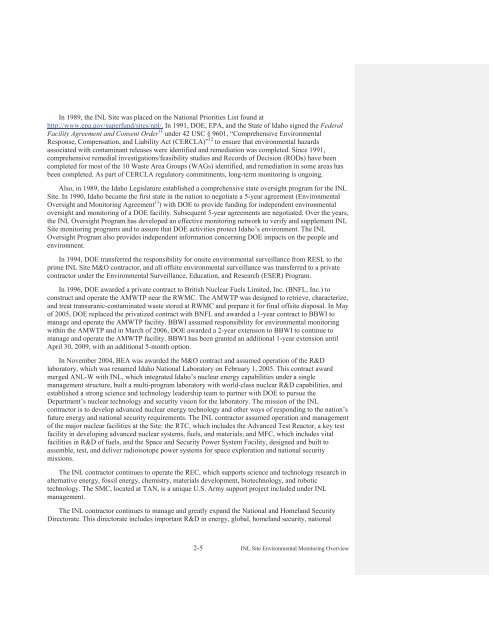Idaho National Laboratory Environmental Monitoring Plan
Idaho National Laboratory Environmental Monitoring Plan
Idaho National Laboratory Environmental Monitoring Plan
Create successful ePaper yourself
Turn your PDF publications into a flip-book with our unique Google optimized e-Paper software.
In 1989, the INL Site was placed on the <strong>National</strong> Priorities List found at<br />
http://www.epa.gov/superfund/sites/npl/. In 1991, DOE, EPA, and the State of <strong>Idaho</strong> signed the Federal<br />
Facility Agreement and Consent Order 11 under 42 USC § 9601, “Comprehensive <strong>Environmental</strong><br />
Response, Compensation, and Liability Act (CERCLA)” 12 to ensure that environmental hazards<br />
associated with contaminant releases were identified and remediation was completed. Since 1991,<br />
comprehensive remedial investigations/feasibility studies and Records of Decision (RODs) have been<br />
completed for most of the 10 Waste Area Groups (WAGs) identified, and remediation in some areas has<br />
been completed. As part of CERCLA regulatory commitments, long-term monitoring is ongoing.<br />
Also, in 1989, the <strong>Idaho</strong> Legislature established a comprehensive state oversight program for the INL<br />
Site. In 1990, <strong>Idaho</strong> became the first state in the nation to negotiate a 5-year agreement (<strong>Environmental</strong><br />
Oversight and <strong>Monitoring</strong> Agreement 13 ) with DOE to provide funding for independent environmental<br />
oversight and monitoring of a DOE facility. Subsequent 5-year agreements are negotiated. Over the years,<br />
the INL Oversight Program has developed an effective monitoring network to verify and supplement INL<br />
Site monitoring programs and to assure that DOE activities protect <strong>Idaho</strong>’s environment. The INL<br />
Oversight Program also provides independent information concerning DOE impacts on the people and<br />
environment.<br />
In 1994, DOE transferred the responsibility for onsite environmental surveillance from RESL to the<br />
prime INL Site M&O contractor, and all offsite environmental surveillance was transferred to a private<br />
contractor under the <strong>Environmental</strong> Surveillance, Education, and Research (ESER) Program.<br />
In 1996, DOE awarded a private contract to British Nuclear Fuels Limited, Inc. (BNFL, Inc.) to<br />
construct and operate the AMWTP near the RWMC. The AMWTP was designed to retrieve, characterize,<br />
and treat transuranic-contaminated waste stored at RWMC and prepare it for final offsite disposal. In May<br />
of 2005, DOE replaced the privatized contract with BNFL and awarded a 1-year contract to BBWI to<br />
manage and operate the AMWTP facility. BBWI assumed responsibility for environmental monitoring<br />
within the AMWTP and in March of 2006, DOE awarded a 2-year extension to BBWI to continue to<br />
manage and operate the AMWTP facility. BBWI has been granted an additional 1-year extension until<br />
April 30, 2009, with an additional 5-month option.<br />
In November 2004, BEA was awarded the M&O contract and assumed operation of the R&D<br />
laboratory, which was renamed <strong>Idaho</strong> <strong>National</strong> <strong>Laboratory</strong> on February 1, 2005. This contract award<br />
merged ANL-W with INL, which integrated <strong>Idaho</strong>’s nuclear energy capabilities under a single<br />
management structure, built a multi-program laboratory with world-class nuclear R&D capabilities, and<br />
established a strong science and technology leadership team to partner with DOE to pursue the<br />
Department’s nuclear technology and security vision for the laboratory. The mission of the INL<br />
contractor is to develop advanced nuclear energy technology and other ways of responding to the nation’s<br />
future energy and national security requirements. The INL contractor assumed operation and management<br />
of the major nuclear facilities at the Site: the RTC, which includes the Advanced Test Reactor, a key test<br />
facility in developing advanced nuclear systems, fuels, and materials; and MFC, which includes vital<br />
facilities in R&D of fuels, and the Space and Security Power System Facility, designed and built to<br />
assemble, test, and deliver radioisotope power systems for space exploration and national security<br />
missions.<br />
The INL contractor continues to operate the REC, which supports science and technology research in<br />
alternative energy, fossil energy, chemistry, materials development, biotechnology, and robotic<br />
technology. The SMC, located at TAN, is a unique U.S. Army support project included under INL<br />
management.<br />
The INL contractor continues to manage and greatly expand the <strong>National</strong> and Homeland Security<br />
Directorate. This directorate includes important R&D in energy, global, homeland security, national<br />
2-5 INL Site <strong>Environmental</strong> <strong>Monitoring</strong> Overview
















